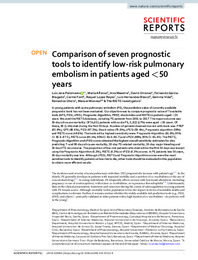Título :
Comparison of seven prognostic tools to identify low-risk pulmonary embolism in patients aged <50 years |
Autor :
Jara-Palomares, Luis
Alfonso, Maria
Maestre, Ana
Jimenez, David
Garcia-Bragado Dalmau, Fernando 
Font, Carme 
Lopez Reyes, Raquel
Hernandez Blasco, Luis M. 
Vidal, Gemma 
Otero-Candelera, Remedios 
Monreal, Manuel 
The RIETE Investigators |
Editor :
Nature Research |
Departamento:
Departamentos de la UMH::Medicina Clínica |
Fecha de publicación:
2019 |
URI :
https://hdl.handle.net/11000/34879 |
Resumen :
In young patients with acute pulmonary embolism (PE), the predictive value of currently available prognostic tools has not been evaluated. Our objective was to compare prognostic value of 7 available tools (GPS, PESI, sPESI, Prognostic Algorithm, PREP, shock index and RIETE) in patients aged <50 years. We used the RIETE database, including PE patients from 2001 to 2017. The major outcome was 30-day all-cause mortality. Of 34,651 patients with acute PE, 5,822 (17%) were aged <50 years. Of these, 83 (1.4%) died during the first 30 days. Number of patients deemed low risk with tools was: PREP (95.9%), GPS (89.6%), PESI (87.2%), Shock index (70.9%), sPESI (59.4%), Prognostic algorithm (58%) and RIETE score (48.6%). The tools with a highest sensitivity were: Prognostic Algorithm (91.6%; 95% CI: 85.6-97.5), RIETE score (90.4%; 95%CI: 84.0-96.7) and sPESI (88%; 95% CI: 81-95). The RIETE, Prognostic Algorithm and sPESI scores obtained the highest overall sensitivity estimates for also predicting 7- and 90-day all-cause mortality, 30-day PE-related mortality, 30-day major bleeding and 30-day VTE recurrences. The proportion of low-risk patients who died within the first 30 days was lowest using the Prognostic Algorithm (0.2%), RIETE (0.3%) or sPESI (0.3%) scores. In PE patients less 50 years, 30-day mortality was low. Although sPESI, RIETE and Prognostic Algorithm scores were the most sensitive tools to identify patients at low risk to die, other tools should be evaluated in this population to obtain more efficient results.
|
Tipo de documento :
info:eu-repo/semantics/article |
Derechos de acceso:
info:eu-repo/semantics/openAccess
Attribution-NonCommercial-NoDerivatives 4.0 Internacional |
DOI :
10.1038/s41598-019-55213-8 |
Publicado en:
Scientific Reports. 2019 Dec 27;9(1):20064 |
Aparece en las colecciones:
Artículos Medicina Clínica
|

 La licencia se describe como: Atribución-NonComercial-NoDerivada 4.0 Internacional.
La licencia se describe como: Atribución-NonComercial-NoDerivada 4.0 Internacional.
.png)